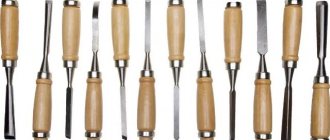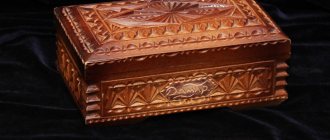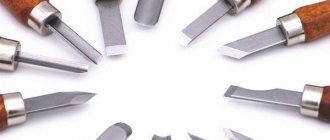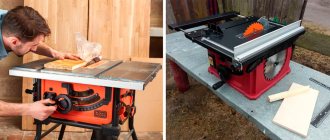It is a tool that is used for hand cutting wood in carpentry. Thanks to the unique shape of the device, it is possible to obtain diverse patterns and indentations of a certain shape on the tree. What exactly can be done with a chisel:
- Form a recess.
- Remove the chamfer.
- Make a carving.
- Make a groove.
- Chop off some of the excess wood.
The chisel consists of only two parts - the working part and the handle. The working part is a metal base of different diameters, shapes and types of sharpening. This is what is used when processing wooden bases. The handle can be plastic (cheap option) or wood (good option).
The sizes of chisels can be completely different. When choosing a tool, you need to consider what manipulations will be performed. The result of the work will depend on the type of cutting edge of the blade. Therefore, carpentry chisels are indispensable when making beautiful parts, figures or furniture from wood.
Types of wood chisels
Working with wood requires the presence of many diverse tools of the same group. Each chisel looks unique due to the structure of the working part and the structure of the metal blade. What types of chisels exist and are widely used in carpentry:
- Straight. This is a basic tool that is used to remove large layers of wood. As a result of the impact, the cells are obtained in the simplest form. This result is possible thanks to the wide blade of the working part of the device.
- An oblique chisel is a subtype of a straight chisel, but the functionality of such a working blade is slightly different. Used to form grooves with a longitudinal shape. You can also “cut down” excess material.
- Semicircular. A semicircular chisel with this sharpening is used in the first stages to form a wooden blank. Used to create complex patterns and ornaments. It has several types of cross-section: round, sloping and medium.
- Caesars. A subspecies of semicircular shaped device, in which the working part is 3 mm. With the help of caesars you can make grooves of shallow depth and a miniature pattern.
- Stichel. The cutter of such a tool is oblique on the working part, and the handle is shaped like a mushroom. This shape of the working part blade is ideal for cutting grooves. At the same time, the elements are accurate and neat.
- Klepik. It has a narrow working part, which is quite functional when making precise and miniature patterns or drawings on wood.
- Marigold. Often used by carpenters when forming patterns consisting of rounded parts and fragments. A small curved working part allows you to remove a minimum layer of wood.
Other types of tools presented can also be used in work, but more rarely. These are chisels of the cranberry type. A semicircular chisel for wood carving is used quite often by carpenters. Thanks to such devices with different base widths, it is possible to obtain diverse patterns and designs on wood, and to form the necessary elements and details.
Learning to work with a chisel correctly
Working with a chisel seems to be not an easy task and quite labor-intensive, which should be learned. For manipulation, force from hand pressure is used. But when there is little strength in the hands, and significant effort is required, in such cases it is appropriate to use a mallet. A mallet is a carpenter's hammer made from hard wood. A chisel paired with a mallet is used only during chiselling. For stripping and trimming procedures, it is permissible to use one chisel.
Before starting work, markings are applied with the device for the shape of the hole, socket or notch. The size of the tool is selected in accordance with the upcoming volume of work and the size of the slotting area. For ease of use, the slotting device is clamped in the left hand, and a mallet is taken in the right. Using a chisel, light taps are applied, which become more and more intensified as they go deeper into the thickness of the material.
Professional carpenters and carvers, as well as home wood craftsmen, always adhere to a certain pattern when working with a device. First of all, a pencil sketch is applied to the wooden blank - a drawing. After that, a recess is cut along the contour using the blade of a knife for wood carving. Only after clearly marking all the contour lines with a knife do they proceed to manipulation with a chisel.
Chisels with replaceable blades.
Methods of using the tool are determined taking into account what type of processing should be performed. As noted above, there are 2 most popular:
- Manual gain. For example, it is used when cutting the edges of a wooden part.
- Strengthening from the impact of another tool (hammer, mallet). It is sometimes required to obtain additional force in the process of gouging recesses or holes in wood.
So, here are the methods for making a chisel:
- forging method
- tools made using this method have a thickened working part and are intended for processing hard wood; - cutting method
- chisels are designed for delicate processing on soft wood. - stamping method
We recommend the length of chisels in the range from 11 to 16 cm. After all, the longer the tool, the less load it can withstand.
Many people prefer wooden handles for work. Despite the fact that they appeared a very long time ago. The material fits snugly in the palm, it is pleasant and relatively light, but it can hardly be called very durable. Of course, this also depends on the method of use: a varnished handle in a workshop will not be damaged for many years, but in difficult conditions it can dry out and crack.
Plastic definitely wins in terms of durability: it does not dry out, does not rot, and can withstand significant impacts, but it may not be suitable for some for reasons of personal comfort.
Sharpening a chisel
One of the main parameters is the sharpening angle. For a chisel it is 20–35 degrees. The smaller the angle, the thinner the chips. For chisels used for cleaning edges, the angle is 20 degrees, for impact and selective ones - 25–30. For sharpening, a special machine and three types of whetstones are used, each subsequent one with a smaller abrasive grain. The ideal condition of the blade is razor sharp.
Depending on the intensity of work with the tool, you have to sharpen the chisel up to twice a year if the blade is made of good steel. In a home workshop, you need to sharpen a tool no more than once a year. When purchasing a tool, check the grade of steel it is made from. The best characteristics are for the brands HVG, 9ХС and 9ХФ, CrV; the blade may also be marked Drop Forged. If there are no inscriptions, then the quality of the material is questionable. Moreover, the information should not be written, but engraved. But for household use, you can also buy a tool with a painted inscription; as a rule, it is sold at a lower price than a professional one.
The size of the chisels is length from 125 to 280 mm with a blade width (depending on the type of blade) of 4–50 mm, weight from 100 to 400 grams. It is best to buy a medium-priced set of chisels, which should contain at least 5 tools. The problem with choosing a suitable chisel, in this case, for any job will automatically disappear.
Types of chisels and their prices
The names of chisels almost completely determine their features and the nature of the work for which they are intended.
This is how a chisel for working wood is:
- Manual - cutting into the material occurs from hand pressure on the handle.
- Impact - cutting into the material occurs by applying light blows with a mallet to the end of the handle, which has a metal butt plate.
A classic chisel has a shaft length of 150–170 mm, while a shortened one has a shaft length of 65–85 mm.
The following chisels are distinguished by purpose:
Carpentry
For fine and precise processing of workpieces, for example, a figured chisel, which allows you to carve hard and soft wood.
The latter include spruce, poplar, and linden.
Plotnitskaya
For rough, rough processing of workpieces of various types of wood.
Turning
For manual processing of parts rotating in a lathe, they are more often called turning tools.
According to the shape of the longitudinal section of the blade, the chisel can be:
Straight
The most common option is with a straight blade and blade, like a ruler.
Curved
With a longitudinal bend of the entire blade and blade.
Klukarza
With a sharp bend of the blade in the longitudinal direction, the beginning of which is located almost at the end of the straight blade. Used, for example, when cutting into door locks.
If the blade of the tool is sharpened on the reverse side, the corresponding classifier word is added to the name, for example, reverse cranberry.
By the way, reversible blades allow you to create convex parts of decorative relief.
According to the cross-sectional shape of the canvas, the chisel can be:
Flat
With a straight flat cross profile. It can be both wide and narrow, thick and thin (according to the parameters of the canvas).
The shape of the blade can be either oblique or straight. In the latter case, the cutting edge is perpendicular to the blade. Used for rough processing and creating straight lines.
Oblique
The previous version has a cutting edge that is beveled relative to the perpendicular to the blade.
This angle of attack makes it easier to cut into the wood base, increasing roughing speed.
Corner
The transverse profile is made in the shape of an angle (the letter “V”). The angle itself, as a rule, is between 60 and 90 degrees.
With such a tool you can make contour and relief carvings, and they can also be used to assign the contour of the future workpiece.
Radial
The cross section is made in the shape of a semicircle. Hence another name - semicircular chisel.
It is designed to perform accurate and smooth penetration into the material, which is probably why it is considered the most popular and in demand.
Such models are used for carving along a contour that has unevenness, where there are no sharp or right angles. The cutting part comes in two shapes: flat and sloping, and can also have a different radius of curvature.
Bracket (box-shaped)
The cutting edge is straight, with sides of different heights and different angles between these elements.
Suitable for even, narrow samples of material.
Cerasik
In structure it is close to the semicircular varinate, but has a significantly smaller thickness. This figured tool is used in artistic carving.
The cost of the types of tools described above is not too different from each other.
As a rule, the average price is 300 – 700 rubles per unit, and it depends, first of all, on the quality of the materials and the brand itself.
So there are models costing 1,300 rubles and more.
At the same time, the promotion of the manufacturer’s company affects pricing not in the least.
For comparison, a set of “Tatyanka” chisels for hand carving made of U10A steel (made by milling, 12 elements included) with a beech handle will cost about 10,000 rubles, that is, approximately 800 rubles each. a piece.
At the same time, Japanese ones are produced using a manufacturing technology different from traditional ones (two-layer steel with a hardness of 60 HRc), with a handle made of Japanese red oak.
For a similar set from Hattori (10 pieces) you will have to pay about 12 - 13 thousand rubles, which is already 1200 - 1300 rubles per piece.
However, the latter can be sharpened to razor sharpness.
Sets with more tools, of course, cost more.
In addition to tools for wood processing, there are options for work:
- For metal - an impact version of the tool with a specific sharpening configuration that allows you to process soft metals, for example, aluminum.
- For stone - a percussion tool, used for chipping material. A stone chisel is also suitable for giving the workpiece a fine faceted shape.
- For concrete - actually a chisel, but with a different configuration of the working part, including a semicircle. In most cases, it has a pobedite solder and acts as an attachment for a hammer drill.
Electric chisel
Along with the usual tool, they actively use its electrical modification, which is called an electric chisel, also known as a renovator.
The working element is a special attachment made in the form of already familiar chisels, which is selected depending on the type of work.
This universal machine is also called an electric chisel, multi-cutter or electric scraper.
The electric chisel has high performance and allows you to perform precise fine carvings.
The cost of such models is 5 – 9 thousand rubles.
In turn, it happens:
- Network - powered from a household network.
- Rechargeable – powered by a removable battery.
In addition to standard ones, there are also special chisels:
Surgical
The instrument used in medicine is made of surgical steel.
Vivid examples are the otolaryngological chisel for rhinoplasty and the Vojacek grooved chisel, which is used for trephination of the mastoid process using the hammerless method.
Pasichnaya
A tool for the daily work of a beekeeper.
A multifunctional chisel with a nail puller function and devices for lifting glued frames is called “European”.
Price – about 300 rubles.
For loops
A specially designed tool designed for knocking out rounded corners of seats for door hinges and locks after they have been milled. It is also called a corner chisel, but structurally it is very different from the tool of the same name described above.
The domestic modified version is the chisel of Pavel Soldatov, named, in fact, by the manufacturer.
The cost of the latter is around 3,400 rubles.
Plastic
For repairing car wheels, or more precisely, for cleaning protrusions, removing bumps and burrs from the tire.
An alternative name is a chisel-scraper.
Essentially an exact replica of a flat, straight instrument, but made entirely of plastic.
Price – about 200 rubles.
An option that resembles a multitool in design, however, without additional tools.
In fact, this is a folding chisel, where, when folded, the blade is located between the halves of the handle.
This allows you to safely transport and store the tool, for example in a pocket or bag.
Cost – from 600 rubles.
Mini chisel
A miniature version of a full-size tool, mainly used for fine carving on soft materials.
Beweiler (Beveller)
A flat-cut tool designed to thin leather at folds.
Alternative names are edge cutter or French chisel.
Cost – from 200 rubles.
Chisel-chisel
A percussion type of tool used to gouge out excess parts of material.
Chisel-jamb
Power sculpture knife (jamb knife) designed for relief geometric carving.
Each of the wood processing tools listed above has its own area of application, and therefore to create just one decorative relief you may need up to 10 different types of it, also of different sizes.
Basic wood carving techniques with a chisel
Techniques for using a chisel are characterized by different positions of the device in relation to the wooden surface.
There are three main ways to work on wood with a chisel:
- Trimming - work is carried out along the side along the fibers; The tool is placed with the unsharpened side of the blade up, holding the handle with one hand and the blade with the other so that the thumb is pointed at the handle. Thanks to this method of holding the chisel, it is easier for the craftsman to set precise forces in order to ultimately obtain the most even and smooth surface of the wood product.
- Side cutting or groove cutting - chisels with a flat blade section are used to produce rectangular grooves. The sharp edge can be oblique or straight. Typically, such a model has a sharpened edge on only one side. Models with a semicircular sharp edge (in the form of a quarter or half a circle) of the blade are used for cutting grooves in a circular manner.
- Perpendicular cutting - the chisel is held by the handle with one hand, and the blade is held with the thumb and forefinger of the other hand. This method involves making single thin cuts of wood chips and will require the most effort compared to the others.
When working manually with this tool, it is better not to cut off a large layer of wood in one fell swoop, but to remove its excess gradually, adhering to the line planned in advance. Working on wood with a chisel requires precision and very precise distribution of effort - if you remove too much material, you will have to start all over again.
A distinction is made between manual strengthening and strengthening using an additional device - a mallet or hammer. They resort to percussion instruments made of wood or rubber in cases where they need to quickly make a depression or hole. But decorative parts with graceful contours require a lot of work and are cut out carefully, slowly, with a precisely calibrated calculation of each effort. After all, it is possible to make aesthetically pleasing and easy-to-use things from wood that will serve the owner for a long time and reliably.
Now solve the crossword puzzle:
This interactive crossword puzzle requires JavaScript and a reasonably recent web browser such as Internet Explorer 5.5 or later, Netscape 7, Mozilla, Firefox or Safari. If you have web page scripting disabled, please enable it and refresh the page. If these web pages are saved on your computer, you may need to click the yellow information bar at the top of the page to allow the puzzle to load.
Welcome
Click on the crossword to start.
Congratulations!
You have completely solved the crossword puzzle.
Universal chisel
Just a few years ago, work with wood was carried out using hand tools, but today there are devices, for example, an electric chisel, that make it possible to significantly facilitate the work of the master, as well as increase the speed of work while maintaining high quality.
An electric chisel is called universal because it allows you to carry out a wide range of work. High-power chisel models can cope with the removal of old parquet boards or rough processing of a large piece of wood, removing knots and other hard inclusions. It is impossible to cope with such work using only hand tools.
This tool is considered universal because it has many attachments of different shapes and sizes. For example, small semicircular and straight 4 mm bits will help you make patterned carvings or engrave the master’s initials, while more massive tools, up to 5 cm wide, are designed for removing wide chips and roughing.
A few words about the structure of the chisel
Where the metal part of the chisel enters the handle, a reinforcing metal ring is sometimes installed. This is done so that the metal part does not get driven into the handle over time and does not split it. This detail applies more to chisels with a wooden handle, and newer models do without a ring.
One of the tool models is designed for working with hard wood. It has a longer cutter and handle. For durable material, an electric chisel is also used.
When the cutter, on the contrary, is shortened and a long handle is used, the tool is optimized for soft wood. You can remove material using only your hands, sometimes resorting to a hammer with a rubber striker.
There is the most delicate area of chisel work associated with inlay and decorative carving. These instruments are made thin and short. Working with them involves solely hand movements, without the use of mallets.
Classifications of chisels
All types of chisels are divided into:
- carpentry;
- wood carvings;
- turning
Cutting pattern with a chisel: 1 – chips, 2 – workpiece, 3, 4 – cutters.
There is another division:
- according to the variant of movement in the thickness of the material;
- according to the shape of the handle;
- to size.
The basis for dividing instruments into groups is also taken as follows:
Operating principle of devices
The movement of the chisel in the thickness of the material occurs due to short taps on the handle with a special percussion instrument: a mallet or a hammer.
This type of hand tool is popular when processing hard woods that require tremendous physical force.
The devices are equipped with an elongated handle and a cutting element. Using a chisel, hold it in your hand, and with the other you perform monotonous taps on the handle. The handle structure is strengthened by a loop. For greater effectiveness of the procedures, use a hammer made of rubber or polyurethane.
Another type of chisel is with a long handle, but a shortened cutter. Their purpose is for manipulation with both hands when moving the instrument.
Chisels (a), flat (b) and semicircular (c) chisels: 1 – blade, 2 – cap, 3 – handle, 4 – ring.
Work with such devices is carried out on soft types of wood. The smooth head of the rounded handle fits comfortably in your fist. It is possible to use a rubber hammer when the density of the wood is high and it is necessary to improve movement in the thickness of the rock.
Test your knowledge - solve the test
Instructions
- Choose one of the options in each of the 8 questions;
- Click on the “Show result” button;
- The script will not show the result until you answer all the questions;
- Look in the window next to the task number. If the answer is correct, then there is a (+). If you made a mistake, there is (-).
- For each correct answer, 1 point is awarded;
- Ratings: less than 4 points - UNSATISFACTORY, from 4 but less than 6 - SATISFACTORY, 6 and less than 8 - GOOD, 8 - EXCELLENT;
- To reset the test result, click the “Reset answers” button;
How to do it yourself
Using available tools, you can make a chisel yourself. In some cases, it is enough to slightly correct the shape and sharpen it, while in others you will have to resort to forging.
Chisel from a milling cutter
Often, a milling cutter is used as a base material for making chisels yourself. The metal of this part is quite durable. It is easy to give it the desired shape. Manufacturing principle:
- Cut out a piece of metal of the required size from the cutter.
- The surface of the workpiece is carefully polished. The workpiece is given the desired shape.
- The next step will be making the handle from wood.
At the end, all the constituent elements are assembled. Usually the handle is made of 2 parts, which are connected by pins.
Metal drill tool
You can make an angular version of the working blade from a drill. How to make a tool from such a base:
- Select a drill with a suitable diameter. Flatten the tip to form the desired thickness and width.
- Using grinding, you can give the knife part the desired shape. A drill can be an excellent base for creating a “nail”.
- The final stage of manufacturing will be the handle. You need to prepare two halves of wood and twist them with a pin.
If you use a drill as a base, you can get a working part of any parameter.
Semicircular chisels
A semicircular chisel for wood carving can be made from a punch that has a similar shape. Algorithm for making a semicircular chisel from a punch:
- Prepare a punch of approximate size.
- Using a grinder, remove the excess part of the radial part.
- While the metal has not cooled down after cutting, you need to immediately sharpen the edges.
- The last step is to sharpen the blade using a grinder.
The tool is ready to use.
We use a file
A file can be an excellent base for making a straight chisel. The working tool is a grinding wheel. But first you need to choose the right file. Take into account the desired parameters of the future device, the type of metal and the grain size of the file.
Using a grinding wheel, all excess is cut off and the desired shape is formed. The next stage will be sharpening and shaping the handle. It is the handle that deserves special attention. Often a standard file tip is used as a base, but it is not suitable for a chisel. You need to flatten the narrow part and only then attach the wooden base.
If you cut the cutters correctly and then perform high-quality sharpening, then you can also get a corner chisel from a file. In this case, you will have to put in more effort.
Files
A needle file is also a good basis for forming homemade woodworking equipment. Manufacturing and processing features:
- The file needs to be heated strongly and evenly. This is necessary in order to perform actions similar to forging.
- After heating, bend the base until the desired shape is obtained.
- The finished workpiece must be immersed in water. This will cool the metal and harden it.
Sharpening the “blade” and attaching the handle will be the final stage in creating the equipment.
Angle chisels
Angle chisels can be obtained from profile tools by heating metal. After heating the workpiece, it is given the desired shape. Then the handle is hardened, sharpened and secured.
A chisel is the main tool in working with wood if you need to create a beautiful pattern, remove excess wood or form a groove. There are many types of this tool, each of which has its own intended use. You can make the device yourself if you use available materials.
Tool structure
The chisel consists of only two parts - the blade (blade) and the handle. At the end of the narrow long flat rod of the blade there is a working part in the form of a transverse blade, straight or rounded with a certain radius. The reverse side of the canvas is pointed in the form of a pin, onto which a wooden handle is stuffed. Some models of chisels are equipped with handles made of durable plastic. In this case, the canvas is simply fused into the handle.
If the handle is wooden, then steel rings are installed on its upper and lower parts to protect it from cracking upon impact. The main role in the purpose of the chisel is played by the type of sharpening of the blade. Typical tools are produced with sharpening:
- straight;
- oblique;
- stapled;
- radius;
- angular.
Straight sharpening is the most versatile. It is a knife blade with an edge perpendicular to the axis of the blade. The sharpening is one-sided, designed for impact use of a chisel. It is quite difficult to manually remove the required layer of wood; considerable effort and certain skills in holding the tool are required.
An oblique or angular chisel is equipped with a blade, the cutting edge of which is located at an angle to the axis of the blade. It is used mainly in a non-impact method for internal extractions and cleaning the corners of grooves and tenons. The smaller the sharpening angle, the easier it is to work with a chisel.
Radius sharpening is used when carving wood surfaces. But a semicircular chisel also allows you to make recesses, for example, grooves for door locks. The peculiarity of such a chisel is that the side walls are not damaged and thin layers of wood do not crack. It also makes it easier to work along curved contours, which is difficult to achieve when working with a straight or oblique chisel.
A U-shaped blade with shortened side walls is used for internal cuts in the side edges of boards and bars. Both the wide side of the blade and the ends of the side walls are sharpened. Working with this type of chisel requires care and professional training.
Carving chisels with a V-shaped blade are also used in carpentry to mark the contours of future recesses. The internal angle of the blade is between 50 and 90 degrees. This type of blade requires good skills when sharpening and working. It is practically not used in amateur work.
An interesting chisel for wood called cranberries. You can recognize it by its curved blade and narrow straight or angular blade. This tool is used for cleaning out samples and sockets along the edges, in places where a regular chisel cannot reach. As a rule, professional carpenters and cabinetmakers use cranberry when making complex products.
What types of chisels are there?
Chisels are divided according to purpose, method of movement on a wood surface, handle shape and dimensions.
Wood chisels.
By purpose they are distinguished:
- carpentry - perform the function of correcting the shape of an object or its parts;
- for cutting - used to obtain decorative elements of an object or to create three-dimensional wood sculptures;
- turning - needed when working with wood on lathes.
How to choose the best tool?
The main parameters of chisels that you should pay attention to when choosing a tool:
- the blade must be hardened, free from rust and other defects;
- the best material for the handle is wood or rubberized plastic;
- price – too low a price for a tool indicates that it is not made with high quality.
The following in the review presents ratings of the best and most popular models of manual and electric chisels in 2021, as well as tool sets.
Top 5 hand chisels
Hart HCC32
5th place
| Characteristics: | |
| Manufacturer country: | Taiwan (brand – USA) |
| Material: | forged steel |
| Canvas length: | 216 mm. |
| Blade width: | 32 mm. |
| Handle: | all-metal |
| Weight: | 610 gr. |
| Guarantee: | — |
| Average price: | RUB 1,150 |
The all-metal construction makes the tool durable and strong. Thanks to special heat treatment, the chisel combines a hard blade and a fairly soft handle. It is suitable not only for cutting and planing, but also for hollowing out niches. Due to the impact blade, the tool can be used like a metal hammer.
Hart HCC32
Advantages:
- wide canvas;
- comfortable all-metal handle;
- blade sharpness;
- In reviews, users speak of the Hart HCC32 as a universal and reliable tool.
Flaws:
- overpriced;
- weight;
- no warranty;
- Among the shortcomings, users note the duration of sharpening.
DYNAGRIP Stanley 0-16-890
4th place
| Characteristics: | |
| Manufacturer country: | China (brand – USA) |
| Material: | steel |
| Canvas length: | 150 mm. |
| Blade width: | 30 mm. |
| Handle: | rubberized plastic |
| Weight: | 300 gr. |
| Guarantee: | 2 years |
| Average price: | 700 rub. |
When it becomes necessary to remove a thin layer from a workpiece, DYNAGRIP Stanley 0-16-890 will cope with this task perfectly.
The blade is made of high carbon steel. The blade, sharpened on one side, ensures reliable operation and withstands shock loads well.
The rubberized handle, with a steel cap at the end, prevents slipping and at the same time, will withstand even blows with a hammer.
DYNAGRIP Stanley 0-16-890
Advantages:
- presence of a protective cap on the handle;
- wear resistance;
- convenient blade sharpening angle;
- affordable price;
- 24 month warranty;
- weight.
Flaws:
- Users complain that the blade becomes dull quickly.
MATRIX Tiger Eye 24503
3rd place
| Characteristics: | |
| Manufacturer country: | China (brand – Germany) |
| Material: | alloy steel |
| Canvas length: | 330 mm. |
| Blade width: | 8 mm. |
| Handle: | rubberized plastic |
| Weight: | 238 gr. |
| Guarantee: | 2 years |
| Average price: | 280 rub. |
MATRIX Tiger's Eye is ideal for craftsmen engaged in figurative carving.
The narrow blade of the chisel and the rubberized handle, which fits comfortably in the hand, will ensure comfortable work even for a novice carver.
Do not be afraid of such a low cost of the tool - the chisel is assembled in China, but this does not affect the quality. Not suitable for processing workpieces.
MATRIX Tiger Eye 24503
Advantages:
- affordable price;
- weight;
- comfortable two-component handle;
- solid, high-quality fabric;
- steel protective cap on the handle;
- wear resistance;
- 24 month warranty;
- long lasting blade sharpness after sharpening.
Flaws:
- narrow scope.
NAREX SUPER 2009 LINE PROFI
2nd place
| Characteristics: | |
| Manufacturer country: | Czech |
| Material: | chrome manganese steel |
| Canvas length: | 132 mm. |
| Blade width: | 16 mm. |
| Handle: | rubberized plastic |
| Weight: | 186 gr. |
| Guarantee: | — |
| Average price: | 900 rub. |
This professional semi-circular chisel is very popular among master carpenters.
The blade, made of special chrome-manganese steel, is wear-resistant, and the blade remains sharp for a long time after sharpening.
The presence of a steel impact tip at the end of the two-component handle allows you to work with both a mallet and a hammer.
NAREX SUPER 2009 LINE PROFI
Advantages:
- weight;
- wear resistance;
- steel protective cap on the handle;
- long lasting blade sharpness after sharpening.
Flaws:
- high price;
- no warranty.
BAHCO Polypropylene 414
1 place
| Characteristics: | |
| Manufacturer country: | Sweden |
| Material: | hardened steel |
| Canvas length: | 140 mm. |
| Blade width: | 15 mm. |
| Handle: | polypropylene |
| Weight: | 214 gr. |
| Guarantee: | 6 months |
| Average price: | 820 rub. |
The special hardening of the BAHCO Polypropylene 414 blade ensures the wear resistance of the tool and the long-term sharpness of the blade after sharpening.
The cutting part does not rust and is not subject to corrosive processes. Suitable for processing any type of wood.
The set includes a special case for storing and transporting the chisel.
BAHCO Polypropylene 414
Advantages:
- comfortable impact-resistant polypropylene handle;
- long lasting blade sharpness after sharpening;
- the presence of a cover for storage and transportation;
- trusted manufacturer;
- wear resistance and durability;
- guarantee;
- the ability to process any type of wood;
- special hardening of the blade;
- weight.
Flaws:
- high price.
Which hand chisel did you like best?
Top 5 renovators
Enkor MFE 400E
5th place
| Characteristics: | |
| Manufacturer country: | China (brand – Russia) |
| Power: | 400 W |
| Nutrition: | from the network |
| Length of cable: | 2.5 m. |
| Weight: | 1.6 kg. |
| Guarantee: | 24 months |
| Average price: | 3230 rub. |
Enkor MFE 400E is a budget-friendly, convenient and easy-to-use unit that can handle repair work and process wood, plastic and even soft non-ferrous metals.
The kit includes a hex wrench, a spatula, a mallet for woodworking, a soleplate for securing sanding sheets, and sanding sheets.
Enkor MFE 400E
Advantages:
- vibration frequency adjustment;
- engine overheat protection;
- case for storage and transportation;
- multifunctionality;
- presence of a soft start function;
- affordable price.
Flaws:
- short cable;
- in reviews, users complain about the noise of the unit and the inconvenient start button;
- high cost of additional attachments.
Skil Masters 1490 NA
4th place
| Characteristics: | |
| Manufacturer country: | China (brand – Netherlands) |
| Power: | 220 W |
| Nutrition: | from the network |
| Length of cable: | 4 m. |
| Weight: | 1.1 kg. |
| Guarantee: | 24 months |
| Average price: | 3600 rub. |
With a device such as the Skil Masters 1490 NA, you can cut plastic, metal, wood and drywall in a corner or niche without much difficulty.
The presence of replaceable attachments allows you to clean or polish workpieces of complex shapes.
The basic package includes a set of blades, a platform for sanding, a set of sanding paper, an adapter for a vacuum cleaner, and a hex key for replacing equipment.
Skil Masters 1490 NA
Advantages:
- soft start function;
- adapter for connecting a vacuum cleaner;
- fixing the start button;
- weight;
- affordable price;
- special bag for storage and transportation;
- ability to process various materials;
- vibration frequency adjustment;
- long cable;
- comfortable two-component handle.
Flaws:
- not found.
Ryobi RMT200S
3rd place
| Characteristics: | |
| Manufacturer country: | USA, Hong Kong, China (brand – Japan) |
| Power: | 200 W |
| Nutrition: | from the network |
| Length of cable: | 2.5 m. |
| Weight: | 1.685 kg. |
| Guarantee: | 24 months |
| Average price: | 4800 rub. |
The body of this renovator model is equipped with two massive rubberized inserts and does not weigh much, which ensures comfortable work on both horizontal and vertical surfaces.
There is a special screw at the bottom of the case for more reliable fixation of the equipment. This is a big plus for novice craftsmen, since there is no chance of the mallet or sanding platform slipping.
The unit is suitable for processing wood, concrete, plastic, and metal.
Ryobi RMT200S
Advantages:
- additional rubberized inserts on the body;
- guarantee;
- weight;
- rotation speed adjustment on the rear handle;
- a special adapter that allows the use of Bosch and Dremel accessories;
- 9 replacement blades, a sanding pad and a set of sanding paper;
- bag for storage and transportation;
- average price.
Flaws:
- short cable;
- lack of soft start;
- There is no adapter for connecting a vacuum cleaner.
Black&Decker MT 300 KA
2nd place
| Characteristics: | |
| Manufacturer country: | China (brand – USA) |
| Power: | 300 W |
| Nutrition: | from the network |
| Length of cable: | 3m. |
| Weight: | 1.58 kg. |
| Guarantee: | 24 months |
| Average price: | 5000 rub. |
Convenient button placement and anti-slip inserts ensure ease of use and durability of this multi-tool.
Particular attention should be paid to the presence of a dust removal system on the body and keyless replacement of attachments.
Black&Decker MT 300 KA
Advantages:
- fixing the start button;
- replacement of equipment without a key, using a special lever;
- body with anti-slip inserts;
- universal adapter, allowing the use of attachments from Bosch, Makita;
- case or suitcase for storage and transportation;
- sanding platform and set of sanding paper;
- adapter for connecting a vacuum cleaner;
- durability;
- adjustment of the rotation speed of the working element;
- engine overheat protection.
Flaws:
- lack of soft start;
- high price;
- in reviews, users complain that the tool heats up;
- it is difficult to find original replacement equipment.
AEG OMNI 300 -KIT1
1 place
| Characteristics: | |
| Manufacturer country: | China (brand – Germany) |
| Power: | 300 W |
| Nutrition: | from the network |
| Length of cable: | 4 m. |
| Weight: | 1.45 kg. |
| Guarantee: | 72 months |
| Average price: | 7450 rub. |
The first place in the ranking of universal electric chisels is occupied by the AEG OMNI 300 -KIT1 - a reliable and high-quality unit, equipped with a backlight, thirteen interchangeable attachments and one vibrating one.
By changing the equipment, the multitool can be used as a drill, screwdriver, jigsaw, or grinder.
AEG OMNI 300 -KIT1
Advantages:
- adjustment of the rotation speed of the working element;
- reliability and wear resistance;
- LED lights;
- three adapters for using equipment from third-party manufacturers;
- a set of consumables and 13 additional attachments;
- bag for transportation and storage;
- 6 year warranty;
- long cable.
Flaws:
- high price;
- lack of soft start function.
Which renovator did you like?











